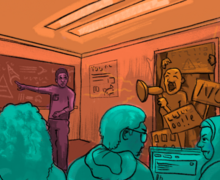SU reaches billion-dollar fundraising goal, but comes up short in 3 of 5 categories
CLARIFICATION: Donations given by foundations and by friends (non-alumni) and parents both made up 14 percent, or a combined 28 percent, of the billion-dollar campaign.
The Campaign for Syracuse University met its largest fundraising goal to date and raised $1 billion three months ahead of its scheduled end date.
When the campaign was conceived in 2005, it was broken up into five subcategories that donors could delegate money to: student access and support, faculty excellence, cross connections, building futures and annual support.
In looking at the breakdown of how much money the campaign raised, it is clear that some sub-goals were well exceeded, while others fell short. This, along with where the donations came from and how they are being used, is indicative of the university’s priorities — its greatest one being student access and support.
In 2005, SU officials set a goal of raising $200 million for student access and support by Dec. 31 of this year. So far, $176,839,532 has been raised in this category. Although this is $23,160,468 short of the university’s goal, enough money has been raised to create 350 scholarships for students.
This support is crucial, said Don Saleh, vice president for enrollment management. There are a little more than 13,000 undergraduate students enrolled at SU this semester, two-thirds of whom receive financial aid from the university.
The money raised for student support is going to have a strong, positive effect, Saleh said.
“It affects our ability to provide quality financial aid packages,” he said. “We have a fund set up that is used at the discretion of the director of financial aid to assist students who might otherwise have to leave the university.”
The campaign allows the university to offer competitive financial aid packages to students. It also allows the university to enroll a socio-economically diverse student body. These, Saleh said, are the two most important aspects of the campaign.
“I think our ability to support students and retain students is enhanced by the campaign,” he said.
In the subcategory of faculty excellence, $150,386,664 has been raised thus far. This too falls short of its initial 2005 goal of $200 million. But due to the help of this money, the number of endowed faculty positions has more than doubled — from 48 to 99. This money has also gone toward faculty research.
Building futures is the subcategory that fell shortest of its initial goal. Of its $225-million goal, the university raised $159,933,885. Money from this category is supporting the renovations in Carnegie Library, the Newhouse II studios and Huntington Hall.
When it comes to donations, Brian Sischo, vice president for development and director of the SU campaign, said it is important to understand that donors dictate what their money goes toward.
“This billion dollars isn’t locked away in a safe somewhere,” he said. “This money is directed to the institution by donors who have passion about certain aspects of the university. And so, our job is to steward those resources consistent with what the donor is interested in supporting.”
Cross connections is a subcategory that raised more money than its initial goal of $300 million set in 2005. As of Aug. 31, this subcategory collected $400,419,759, surpassing its goal by $100,419,759. This money has gone toward advancing interdisciplinary teaching, as well as the creation of facilities such as Dineen Hall and Newhouse III.
In 2010-11, tuition and fees accounted for only 88 percent of the university’s costs, according to the 2010-11 giving report for the SU campaign. The annual funds subcategory helps bridge this gap. The university aimed to raise $75 million in this category, but well surpassed this goal by raising $92,712,877.
It is important to note that $28,320,013 has yet to be delegated to a specific subcategory, Sischo, the vice president for development and director of the SU campaign, said.
“Some of that may very well end up in the faculty line or in the student line,” he said. “The objective would be that by the end of the campaign, or shortly thereafter, that all of that pending has been designated.”
It is also important to note, Sischo said, that the campaign is made up of both financial gifts and pledges. The university has received approximately half of what it has raised in the campaign in cash.
Along with reaching its overarching goal of raising $1 billion, the university also managed to set up and secure a network of alumni, a resource that is incredibly valuable to students, Sischo said.
In fact, alumni donated about 48 percent of the money collected by the campaign. Corporations made up about 25 percent of the donations, while foundations and friends (non-alumni) and parents both made up about 14 percent of donations.
“Part of this is not necessarily about trying to squeeze every last quarter out of students, by any means, but to help build a culture of philanthropy so that students recognize that a lot of what they have here today is as a result of the alumni who were once students as well,” Sischo said.
In this way, Sischo said, university officials hope to inspire students to stay connected with the university once they graduate.
What is most impressive about the Campaign for Syracuse University is the number of donations the university received, Sischo said. The campaign collected 191 donations of $1 million or more, including 30 donations of $5 million or more, from more than 60,000 donors.
The university will continue to raise money for similar efforts, regardless of whether an official campaign is in place, Sischo said. Personally, he said, he hopes to see the campaign raise $1,044,000,000 by Dec. 31.
Regardless of which subcategories surpassed or fell short of their 2005 goal, Sischo said the university’s first priority remains making education accessible to students of all financial backgrounds.
“In an era where the cost of higher ed remains ever-growing, the challenge that today’s students are facing, particularly middle-class students are seeing increasing debt loads upon graduation,” Sischo said. “This is something that the institution cares deeply about, and we’ll see continued efforts to try to offset that trend.”
Published on September 17, 2012 at 3:10 am
Contact Stephanie: snbouvia@syr.edu | @snbouvia







